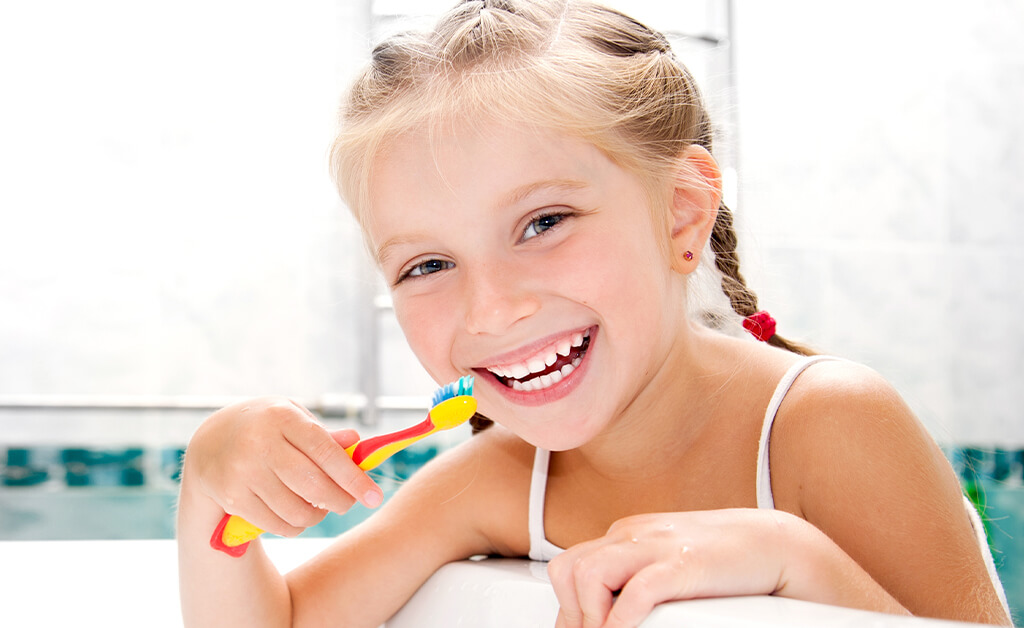At Southmoor Pediatric Dentistry, we’re big believers in doing everything we can to protect your child’s smile–and that’s where fluoride comes in. This magical mineral found in toothpaste, professional fluoride treatments, and even our water plays a big role in keeping your child’s smile bright and healthy. Best of all, it can be used effectively both at the dentist office and at home.
Is fluoride good for kids? How much fluoride is too much? Can children get fluoride side effects? Keep reading to learn five kid fluoride facts that answer these questions and more.
Kid fluoride fact #1: Fluoride is natural
Fluorine, from which fluoride is derived, is the 13th most abundant element and is released into the environment naturally. In fact, fluoride (pronounced FLOOR-ide) is naturally present in all water – it’s like nature’s gift to our teeth!
However, the fluoride that occurs naturally in water is not usually at a high enough level to protect our teeth. That’s why extra fluoride—the official level recommended by health officials is 0.7 parts per million—is added to water in the United States and many other countries. This number may not sound like much, but a little fluoride goes a long way.
Kid fluoride facts #2: Fluoride is good for teeth
Fluoride, which strengthens teeth and repairs the damage caused by tooth decay, can help your child’s teeth at any age–even when they are babies. The American Academy of Pediatrics recommends using a soft washcloth or baby toothbrush to wipe your baby’s gums and teeth with water or even a tiny “smear” of fluoride toothpaste (the size of a grain of rice) once their first tooth appears. At age three, you can begin using a pea-sized drop of fluoride toothpaste twice a day.
As your child grows, bacteria in their mouth combines with sugars and makes acid that can harm the outer layer of their teeth (also known as the enamel). Fluoride protects teeth from damage and can even help rebuild the enamel. So, is fluoride good for kids’ teeth? The answer is a resounding yes!
Kid fluoride facts #3: There are lots of ways to safely use fluoride
Brushing with fluoride toothpaste and drinking fluoridated water are two of the easiest ways to use fluoride–and yes, your child can safely do both without any fluoride side effects.
Here are some kid toothpaste tips and tricks to help keep them safe and maximize the benefits of fluoride:
- Always use the recommended amount of toothpaste for your child’s age.
- Use a timer, sing a song, or count out loud to make sure they brush for two full minutes before spitting out all the toothpaste.
- Supervise their brushing (especially young children under the age of six) so they do not swallow any toothpaste.
Many parents wonder how much fluoride is too much for kids or if their child could experience fluoride side effects. There is a risk of fluorosis–an enamel condition that appears as faint white streaks on the teeth–if too much fluoride is ingested. If you have any questions, contact the Southmoor Pediatric Dentistry team.
Kid fluoride facts #4: There’s more than one type of fluoride
There are two types of professional fluoride treatments to help strengthen teeth. Topical fluoride is applied to the surface of any erupted teeth and acts directly on the enamel. Topical fluoride can be found in toothpaste, mouth rinse, and fluoride varnish, which is quickly applied with a small brush at the dentist’s office.
Systemic fluoride is incorporated into developing unerupted teeth (the ones you can’t see!). Systemic fluoride includes fluoridated water and dietary fluoride supplements. These supplements are available only by prescription and come in the form of tablets, drops, or lozenges.
Kid fluoride facts #5: Fluoridated water is worth it
Fluoridated water provides both topical benefits (when it comes in contact with the teeth) and systemic benefits (when it is swallowed). Drinking water with fluoride coats your teeth in small amounts of fluoride throughout the day, helping to prevent cavities before they start.
Fluoridated water reaches over 60% of the U.S. population through public water sources. There are various ways to find out if the water your household drinks contains fluoride:
- Water from a public source – Call your local water utility company or public health department
- Water from a private source – Contact the supplier
- Bottled water – The fluoride level should be on the label
- Well water – The fluoride level can be tested at a laboratory or by the public health department
Community water fluoridation is an extremely effective and inexpensive means of obtaining the fluoride necessary for optimal prevention of tooth decay. If your community’s water supply has low levels of fluoride, you can increase your fluoride consumption by simply adding fluoride to your daily routine. If you are unsure about your community’s water, ask your dentist and/or contact your public health department or water supplier.
Schedule an appointment today
Want to find out more about fluoride? The expert team at Southmoor Pediatric Dentistry is here to help. It’s our goal to give you and your child every reason to smile.
You’ll know from the minute walk through our doors that Southmoor is a special place. Come experience our quality care and patient-centered focus for yourself! Contact us to schedule an appointment today.
